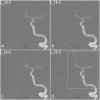Spot fluoroscopy: a novel innovative approach to reduce radiation dose in neurointerventional procedures
- PMID: 27522095
- PMCID: PMC5347367
- DOI: 10.1177/0284185116658682
Spot fluoroscopy: a novel innovative approach to reduce radiation dose in neurointerventional procedures
Abstract
Background Increased interest in radiation dose reduction in neurointerventional procedures has led to the development of a method called "spot fluoroscopy" (SF), which enables the operator to collimate a rectangular or square region of interest anywhere within the general field of view. This has potential advantages over conventional collimation, which is limited to symmetric collimation centered over the field of view. Purpose To evaluate the effect of SF on the radiation dose. Material and Methods Thirty-five patients with intracranial aneurysms were treated with endovascular coiling. SF was used in 16 patients and conventional fluoroscopy in 19. The following parameters were analyzed: the total fluoroscopic time, the total air kerma, the total fluoroscopic dose-area product, and the fluoroscopic dose-area product rate. Statistical differences were determined using the Welch's t-test. Results The use of SF led to a reduction of 50% of the total fluoroscopic dose-area product (CF = 106.21 Gycm2, SD = 99.06 Gycm2 versus SF = 51.80 Gycm2, SD = 21.03 Gycm2, p = 0.003884) and significant reduction of the total fluoroscopic dose-area product rate (CF = 1.42 Gycm2/min, SD = 0.57 Gycm2/s versus SF = 0.83 Gycm2/min, SD = 0.37 Gycm2/min, p = 0.00106). The use of SF did not lead to an increase in fluoroscopy time or an increase in total fluoroscopic cumulative air kerma, regardless of collimation. Conclusion The SF function is a new and promising tool for reduction of the radiation dose during neurointerventional procedures.
Keywords: X-ray; collimation; digital subtraction angiography (DSA); dose saving; fluoroscopy; neurointervention.
Figures







References
-
- Klein LW, Miller DL, Balter S, et al. Occupational health hazards in the interventional laboratory: Time for a safer environment. Radiology 2009; 250: 538–544. - PubMed
-
- Dose-Area Product. Conference of Radiation Control Program Directors (CRCPD) 205 Capital Avenue Frankfort, KY 4060, First published: October 2001, Reviewed/Republished: September 2008. Available at: http://www.crcpd.org/Pubs/QAC/DAP.pdf.
-
- Muroi T, Tanaka M, Shimizu Y, et al. Medical Diagnostic Imaging Apparatus. PCT/JP2013/052412. 2013.
Publication types
MeSH terms
LinkOut - more resources
Full Text Sources
Other Literature Sources
Medical

